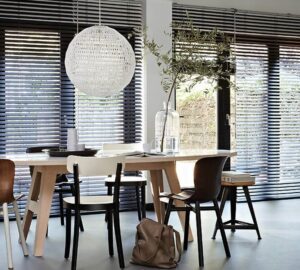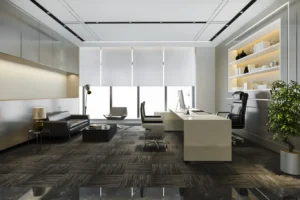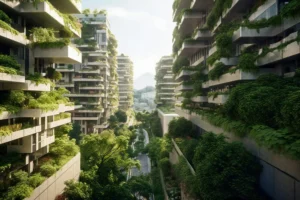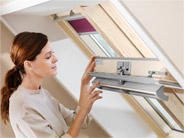No one could have failed to notice that energy prices have risen dramatically over the past few months and continue to rise. This puts a significant strain on the Danish economy, with many unable to afford other necessities. Skyrocketing energy prices are also putting pressure on businesses, organizations and the public sector.
But there are solutions that can reduce energy consumption and save you money. Solar shading is one of the most popular ways to lower energy costs while reducing a building’s carbon footprint.
Good solar shading reduces heating/cooling (HVAC) loads, and interior blinds can save up to 16% of heating, ventilation and air conditioning (HVAC) energy and roller bl inds up to 27%.
With externally mounted solar shading methods, the savings in HVAC energy can be up to a staggering 54%. Thus, solar shading constitutes a self-financing climate control system in the way it improves insulation, manages solar control and maximizes daylight from glass units. With this in mind, solar shading represents an investment that is paid back through the savings in energy consumption.
Solar shading is a win in all seasons
Fixed solar shading designed and configured according to the high seasonal angles of the sun can reduce solar gain in the summer (reducing heat gain by as much as 80%), but still allow heat gains from the low-angled sun in cooler months, helping to reduce space cooling and heat loads.
In summer conditions, external solar shading is particularly effective in preventing solar radiation from reaching glass surfaces and also reduces the proportion of solar radiation in the short-wave infrared range that is absorbed and re-radiated as thermal radiation. This can eliminate the need for the use of air conditioning.
In winter, a fully closed shading system is particularly effective at providing insulation at night, while maximizing solar energy when open during the day. Motorized shading solutions require electricity. But even here, installing electric solar shading will provide a significant benefit with less energy consumption and costs, compared to the cost of mechanical heating and cooling.
Comfortable temperature throughout the building
For those looking to reduce energy bills through solar shading solutions, there are a number of ways this can be done.
Usually, the south-facing elevation of a building is where the majority of solar shading will be needed. Where large areas of windows and doors are located on this elevation, a significant amount of heat can accumulate inside the interior space of a building as the sun’s rays penetrate the glass throughout the day.
With solar shading for windows and doors, the amount of direct sunlight entering the center of the building can be greatly reduced, leading to a cooler and more comfortable indoor temperature.
Of course, it’s also worth noting that potential property buyers or tenants will be influenced in their decision to buy or rent if the building is more energy efficient with lower running costs – especially in light of the energy crisis.
In summary, solar shading can help reduce energy costs by
- Maximize natural daylight
- Reduce overheating
- Used as a form of insulation
- Reduce the need for internal cooling systems
- Reduce the need for internal heating systems
- Reduce the use of artificial lighting
Solar shading effect on older buildings
While a percentage of older buildings would have been considered energy efficient by the standards of the time, by today’s standards they have a higher carbon footprint than newer buildings. This means that older buildings need a high energy input to keep the internal temperature at an optimal level.
Since solar shading can be retrofitted to any building, including older buildings, making them more energy efficient, it’s a simple and less intrusive way to improve a building’s climate performance and lower energy costs. It’s also worth pointing out that while solar shading serves a practical purpose, it can be manufactured to bespoke specifications and therefore integrated into the style of the home/building.
However, be aware that there may be factors in the design and construction of the building and access to the area requiring shading that influence the retrofit.
Reducing energy costs with solar shading in a new build
Some new builds are so well insulated that heat retention is a key issue, especially if solar shading is not factored into the design and construction. In addition to being well insulated, newly built commercial and residential premises often have large windows, resulting in greenhouse-like conditions.
This problem will become more significant in the face of global warming, with higher temperatures, As temperatures continue to rise, the need for efficient cooling of buildings is crucial.
In many buildings, an air conditioner is traditionally required to work continuously to cool the space and keep the internal environment comfortable. The downside of using air conditioning regularly is that it will inevitably lead to expensive energy bills and may require regular maintenance.
This is where solar shading with its minimal maintenance, versatility and passive house effect can make a big difference. Having a solar shading system installed can help reduce heat gain in the summer, heat loss in the winter, while controlling light levels and providing the benefit of natural light.
Energy efficiency and increased comfort in the workplace
Many businesses, organizations and government institutions will look to other areas to save money. As mentioned, solar shading can not only reduce energy costs, but it can also help offset rising energy bills in other ways, helping businesses weather the potential economic storms ahead. By increasing thermal, visual and acoustic comfort with solar shading, overall staff satisfaction, wellbeing and productivity can be improved.
In office buildings, the optimal summer working environment should be around 24°C+/-3°C. Research has shown that this is the ‘comfort zone’ for many people. When these temperatures are significantly exceeded, it’s no longer just a matter of comfort, but can quickly escalate into a health and safety risk.
In the warmer summer months, solar radiation can increase the internal building temperature to as high as 35 – 40°C. At these temperatures, people are at risk of dizziness, fainting, heat cramps and, in more severe cases, heat stroke or collapse.
Scientific studies show that increased temperatures directly correlate with absenteeism and negative productivity: as temperatures increase, productivity decreases. At 28°C, there can already be a 5% drop in productivity.
Reduce sick days and protect your inventory
With a healthy building and work environment, fewer sick days are taken, resulting in a reduction in sick pay and the need to hire freelance/temporary staff that can cost more than regular staff – especially where agencies are involved.
Since solar shading disperses the direct glare from the sun’s rays, it is also beneficial for preserving the appearance of light-sensitive paints and soft furnishings, as well as consumer goods and valuables such as clothing, paintings and prints, books, tapestries and antique textiles, wallpaper, wooden furniture and other home furnishings. It therefore helps to reduce the degradation of saleable goods and the need for expensive maintenance and replacement of materials.










